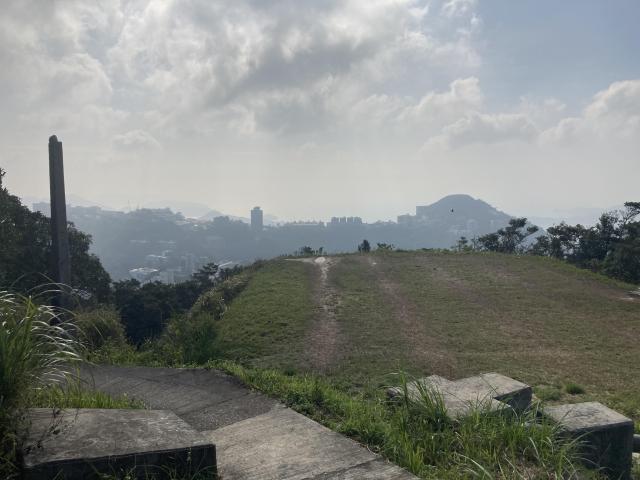We came across a site, which is just located a bit higher up next to the former Eyrie compound. Walking up to this site we could see many of this pillars, like the one on the photograph (to the left). What building or villa stood there before ? Thank you and best regards, Daniel
Date picture taken
unknown
Shows place(s)

Comments
Terrace near Eyrie Site
Hi Daniel,
I'm not 100% sure if I'm thinking of the same place as in your photo, but if I am then it's a covered reservoir. I think the pillars you mentioned were lamp posts to light the path.
The covered reservoir I am referring to is the flat patch slightly to the left and further away than the white building in the lower centre of the following photo.
Eyrie Site
Hi GW,
Thanks a lot for your reply. It's exactly the same place as from my previous photo. Of course the area was much open at that time. Now it's all covered by trees and bushes. Interesting to know that this is a covered reservoir. This reservoir must have been built long time ago, because there is a massive stone wall around the covered reservoir.
Once again thanks for the photo and your reply.
Have a great Sunday and Best Regards, Daniel
Yes, it is definitely the
Yes, it is definitely the covered reservoir right next to the old R.A.F. Battys compound. If you search through the 367 Association Gallery you will find quite a few more images of that area uploaded by me but taken by members of the 367 Association when they worked in that compound in the 1950s. You will also be able to see some of them, if I remembered to link them, with the RAF Battys Belvedere pin on the Gwulo map. I don't think that the reservoir is earlier than the early 1950s, but it is clearly identified as a blue rectangle on the map. Best wishes, Andrew
The reservoir is very old
Hi, the reservoir you mentioned is the Peak Service Reservoir, and it has been confirmed it was completed in 1897, with "the roof formed of brick arching built in cement mortar".
What's the purpose of
What's the purpose of erecting the cement pole seen on the left of your photo? There's another one further down the steps.
I seem to be able to note the two of them from A. Suddaby's photo too (posted by gw). If I am not mistaken, they were at the triangular junction between the "haunted" brick house and the RAF building.
There seems to be similar ones up on Pottinger Peak
Reservoir on the Peak
I have a very strong feeling that the grass covered reservoir next to the old R.A.F buildings on the Peak, which I have stood on several times over the years, is not the one that replaced the small, iron Victorian one. I draw your attention to the photograph, 'Battys b' in Peter Keely's gallery within the 367 Association that was taken in 1952/5 which I include below. The comment in his gallery states,"Peter wrote that here he is standing on the flat roof of the [then] single storey R.A.F. building, with the retaining wall behind him and the unit's incinerator next to the old water tank that would shortly be replaced by the new, covered reservoir". So, I suspect that the metal reservoir shown on his photograph, and which is also on the aerial one taken by Ken Sly in the 367 gallery, is not the Victorian one but one that was installed by the military prior to the R.A.F. moving onto the site in the early 1950s. If that is the case there have been 4 reservoirs (2 metal tanks and 2 covered ones in that vicinity.
Cement poles
These posts photographed by me in December 2005 were lamp posts, erected close to some potentially dangerous steps near the top of the path leading up to the 1950s R.A.F. outpost known as Battys (Belvedere) that was built on the site of the old Victorian signal station. Personnel worked round the clock shifts at the outpost and while most of the path up from where the R.A.F. transport dropped them in a layby just above the Peak police post, some lighting was maintained at strategic places. On my attached photograph you will see the small metal door giving access to the electricals at the foot of the uppermost post. They were both just below the 'modern' covered water reservoir, not near the ruined brick 'haunted' house that features on several of the photographs in the 367 Association gallery.
Incidentally, the old building that features on several of the Victorian photographs of the signal statioin was still there in trhe 1950s and it is clearly visible at the bottom of the second photograph and is also on the one taken by Ken Sly at the top of this thread. Andrew
Many thanks for the
Many thanks for the information, for my friends and I have asked quite some persons without a proper answer, so that solves the mystery.
Any photos of the closer look with the lamp posts intact, so that we can see how the top part looked like?
Possible Intact Lamp Post Appearance
Having done some searching on the site, I came across a photograph of RAF Little Sai Wan containing a concrete lamp post which looks rather similar to the ones at the Peak. The lamp post with the curved top is in the centre-bottom of the picture:
Christmas 1954. | Gwulo
Note the two chamfers on the pictured lamp post which match those on the Peak lamp posts. Although the Peak ones appear to have a shallower chamfer than the ones at Little Sai Wan, military standardisation suggests to me that these lamp posts would be of the same type. Hope this helps!